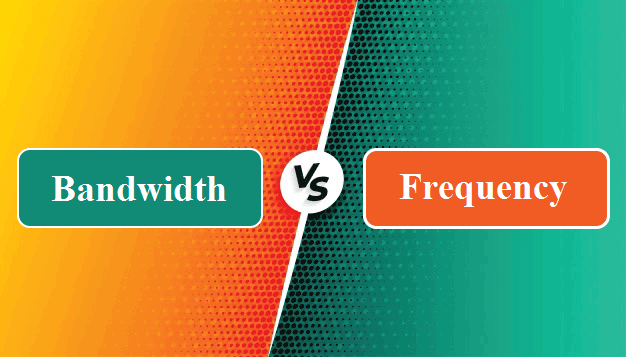Difference between Bandwidth and FrequencyBandwidth and Frequency are two properties that are studied in electronics research. Frequency and bandwidth are the two most important terms in data transmission. However, in the context of networking, these two propertiesz have different meanings. The primary distinction between frequency and bandwidth is that frequency indicates the number of complete cycles that appear in unit time. Conversely, bandwidth is the total quantities of data transmit in a unit of time. The measurement unit for both frequency and bandwidth is Hertz. In this article, you will learn about the difference between Bandwidth and Frequency. But before discussing the differences, you must know about Bandwidth and Frequency. What is Bandwidth?Wireless communications are normally carried out over a limited range of frequencies, known as a frequency band. This frequency band is known as the bandwidth. It is a networking term that refers to the maximum quantity of data that may be sent per unit of time. In technical terms, bandwidth is frequency range within a given band that is typically used for signal transmission. Signal bandwidth refers to the frequency range that makes up a specific signal. Assume two points on the frequency scale are f1 and f2, and the bandwidth is provided by f2 - f1 in Hertz or Hz. A voice signal doesn't have a single unique frequency but is composed of waveforms of many frequencies, making it difficult to forecast the exact signal's frequency. As a result, you can define a bandwidth for speech signals as the difference between the signal's lowest and highest frequencies. You may apply the following formula to calculate the bandwidth is as follow: B = [f(max) - f(min)] bits/sec Here, bandwidth is denoted by B, and f(max) and f(min) are the frequency. What is Frequency?The term "frequency" defines the number of oscillations that happen in a data transmission per second. In terms of networking, the data is transmitted in the form of signals, which are composed of waves. The number of oscillations per second specifies the signal frequency. It is commonly measured in Hertz (Hz). In the event of sound, frequency is a measure of the pitch of the sound: High-frequency sounds have a high pitch ("treble"), while low-frequency sounds have a low pitch ("bass"). For example, if a current completes one cycle in one second, its speed is one Hertz (Hz). If the current complete 60 cycles in one second, the frequency is 60Hz. A computer's clock speed is often measured in gigahertz (GHz) and megahertz (MHz). Frequency is also significant in wireless communication, where a signal's frequency is mathematically connected to its wavelength. You may apply the following formula to calculate the frequency is as follow: Here, f is the frequency of the signal wave, and T is the time of the oscillation in seconds. Key Differences between the Bandwidth and Frequency
Here, you will learn the various key differences between Bandwidth and Frequency. Various differences between Bandwidth and Frequency are as follows:
Head-to-head comparison between Bandwidth and FrequencyHere, you will learn the head-to-head comparisons between Bandwidth and Frequency. The main differences between Bandwidth and Frequency are as follows:
ConclusionA radio channel's capacity is determined by the frequency at which messages are sent and the quantity of energy required sending them. Because capacity is determined by frequency bandwidth, bandwidth is loosely defined as the quantity of information transferred per second. However, bandwidth is the size of the frequency band, which is the difference between the band's lowest and highest frequencies. As a result, channel capacity is proportional to signal bandwidth. In contrast, frequency is utilized to evaluate processing speed and is determined as the rate at which radio signals transmit and receive communication signals. Frequency standards connect the various areas by utilizing a common unit, the hertz.
Next TopicDifference between
|
 For Videos Join Our Youtube Channel: Join Now
For Videos Join Our Youtube Channel: Join Now
Feedback
- Send your Feedback to [email protected]
Help Others, Please Share










